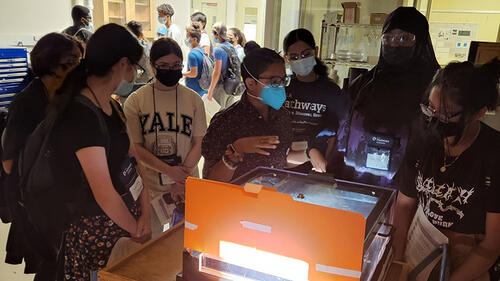
In July 2022, members of the Wright Lab community taught three workshops and also led several enrichment activities during an “open house” of Wright Lab for the 2022 Pathways Summer Scholars–a free two-week summer science program exclusively for 100 high school students from the Yale Pathways to Science program. More details and photos from the events are below.
Open House
The Wright Lab open house on July 13 included a brief tour of the common facilities of Wright Lab, led by program manager Victoria Misenti, and two demo stations:
Discovering the invisible universe with particle detectors
Led by: graduate students Sumita Ghosh and Samantha Pagan, with additional input from postdoctoral associate Jorge Torres
Description: In this station you will learn the basics of a cloud chamber, a rudimentary and old version of a particle detector. In a cloud chamber, charged particles leave visible tracks of different shapes allowing the identification of the particles that generated them. You will count the number of cosmogenic muons, a type of particles coming from outside the Earth, that pass through the cloud chamber and then calculate the rate in units of time and area. After that, you will learn to use a more modern setup and compare your results with those of the modern particle detector.
Cool Physics
Led by: graduate student Emily Pottebaum
Description: Matter can exhibit very odd behavior in extreme cold. In this session we’ll use liquid nitrogen to levitate magnets, shatter rubber, light a light bulb, and more!
Workshops
The 5-day workshops, held July 18-22, included:
The Physics of Light
Led by: associate professor David Moore and graduate students Jiaxiang Wang, Molly Watts, Sierra Wilde, and Yu-Han Tseng
Description: For all of us who can see, we experience light and color every moment. But what are they? We will explore light’s visible and invisible properties, and how these properties enable technologies from lasers to smart phones.
Let’s Smash the Proton
Led by: associate research scientist Raghav Kunnawalkam Elayavalli
Description: What makes up matter? Is anything smaller than the proton? Find out by smashing protons with electrons in computer simulations and studying the debris–just like physicists at the next-gen particle collider.
Measuring Earth’s Velocity with a Radio Telescope
Led by: graduate student Will Tyndall and undergraduates Audrey Cesene, Audrey Whitmer, Ana Maria Melian, and Spencer Greenfield, of assistant professor Laura Newburgh’s group, and based on Digital Signal Processing in Radio Astronomy (DSPIRA) work
Description: How do we know our galaxy is rotating? Is this evidence for dark matter? Use a simple radio telescope to observe hydrogen gas in our galaxy and chart how it moves.

